Investigating the Human Impacts and the Environmental Consequences of Microplastics Disposal into Water Resources
Abstract
:1. Introduction
1.1. Plastics in a Global Environmental Context
1.2. Microplastics in Marine Environments
1.3. Policies and Regulations of Microplastics’ Existence in Marine Environments
- Promotion of green chemistry by avoiding POPs or substituting harmful chemicals in MP and endocrine-disrupting chemicals (EDCs),
- MP waste prevention through developing and implementing safe alternatives to persistent plastics in marine environments,
- Research in the field of environmental and health impacting on marine plastics through EDCs’ and POPs’ fate at micro- and macro- scales,
- Eco-design packaging and MP waste recycling,
- Promotion of best alternative techniques to control MP leakage to open oceans, while gathering information about input loads, sources, and originating sectors,
- Collection and environmental management of MP waste, while improving the efficiency of the whole treatment,
- Consumerism changes and disposal behavior of MP litter.
1.4. Bibliometric Analysis of Microplastics Reporting in the Scopus Database
2. Methods and Analyses
2.1. Definitions and Sampling
2.2. Analytical Τechniques and Εlemental Analyses
2.3. Bacterial-Based Analyses
2.4. Modeling of Microplastics—Analytical Τechniques
3. Compounds Detected in Microplastic Samples
3.1. Sizing and Characterization of Microplastics
3.2. Microbiology and Toxicological Conditions of Microplastics
4. Discussion, Environmental Considerations, and Challenges
- (a)
- further and fully investigate how MPs are considered as dominant anthropogenic pollutants of ecological risk,
- (b)
- support the primary scope of science and society in tackling such a global environmental issue in the future [45],
- (c)
- (d)
- reinvent plastics production under the environmental considerations and the social provisions for radical modes of eco-design plastics production, biodegradable plastics production, as well as a circular thinking of manufacturing production, making the used plastic products able to undergo a second round of use after recovering and recycling. Moreover, legislative framework updating and WWTPs’ adaptation to the aforementioned directions should be shown to be vital tools to endorse those safety regulations of MP pollution decrease in the contexts of circular economy and the employment of effective practices to control the plastic waste crisis [70,71].
5. Conclusions
Author Contributions
Funding
Conflicts of Interest
References
- Ma, H.; Pu, S.; Liu, S.; Bai, Y.; Mandal, S.; Xing, B. Microplastics in aquatic environments: Toxicity to trigger ecological consequences. Environ. Pollut. 2020, 261, 114089. [Google Scholar] [CrossRef]
- Alimba, C.G.; Faggio, C. Microplastics in the marine environment: Current trends in environmental pollution and mechanisms of toxicological profile. Environ. Toxicol. Pharmacol. 2019, 68, 61–74. [Google Scholar] [CrossRef] [PubMed]
- Guo, X.; Wang, J. The chemical behaviors of microplastics in marine environment: A review. Mar. Pollut. Bull. 2019, 142, 1–14. [Google Scholar] [CrossRef]
- Zobkov, M.B.; Esiukova, E.E. Microplastics in a Marine Environment: Review of Methods for Sampling, Processing, and Analyzing Microplastics in Water, Bottom Sediments, and Coastal Deposits. Oceanology 2018, 58, 137–143. [Google Scholar] [CrossRef]
- Liu, F.F.; Wang, S.C.; Zhu, Z.L.; Liu, G.Z. Current progress on marine microplastics pollution research: A review on pollution occurrence, detection, and environmental effects. Water 2021, 13, 1713. [Google Scholar] [CrossRef]
- Tang, S.; Gao, L.; Gao, H.; Chen, Z.; Zou, D. Microplastics pollution in China water ecosystems: A review of the abundance, characteristics, fate, risk and removal. Water Sci. Technol. 2020, 82, 1495–1508. [Google Scholar] [CrossRef]
- Barcelo, D.; Pico, Y. Case studies of macro- and microplastics pollution in coastal waters and rivers: Is there a solution with new removal technologies and policy actions? Case Stud. Chem. Environ. Eng. 2020, 2, 100019. [Google Scholar] [CrossRef]
- Hermabessiere, L.; Himber, C.; Boricaud, B.; Kazour, M.; Amara, R.; Cassone, A.L.; Laurentie, M.; Paul-Pont, I.; Soudant, P.; Dehaut, A.; et al. Optimization, performance, and application of a pyrolysis-GC/MS method for the identification of microplastics. Anal. Bioanal. Chem. 2018, 410, 6663–6676. [Google Scholar] [CrossRef] [Green Version]
- Harrison, J.P.; Schratzberger, M.; Sapp, M.; Osborn, A.M. Rapid bacterial colonization of low-density polyethylene microplastics in coastal sediment microcosms. BMC Microbiol. 2014, 14, 232. [Google Scholar] [CrossRef] [Green Version]
- Olarinmoye, O.M.; Stock, F.; Scherf, N.; Whenu, O.; Asenime, C.; Ganzallo, S. Microplastic Presence in Sediment and Water of a Lagoon Bordering the Urban Agglomeration of Lagos, Southwest Nigeria. Geosciences 2020, 10, 494. [Google Scholar] [CrossRef]
- Issac, M.N.; Kandasubramanian, B. Effect of microplastics in water and aquatic systems. Environ. Sci. Pollut. Res. 2021, 28, 19544–19562. [Google Scholar] [CrossRef]
- Galafassi, S.; Nizzetto, L.; Volta, P. Plastic sources: A survey across scientific and grey literature for their inventory and relative contribution to microplastics pollution in natural environments, with an emphasis on surface water. Sci. Total Environ. 2019, 693, 133499. [Google Scholar] [CrossRef]
- Dimaano, R.J.D.; Albo, A.C.; Adion, A.X.Z.M.; Brucal, J.K.H. Antipara (Analysis of tiny particles in aquatic environment): A water scanning device for microplastics. Int. J. Adv. Trends Comput. Sci. Eng. 2020, 9, 5217–5221. [Google Scholar] [CrossRef]
- Novillo, O.; Raga, J.A.; Tomás, J. Evaluating the presence of microplastics in striped dolphins (Stenella coeruleoalba) stranded in the Western Mediterranean Sea. Mar. Pollut. Bull. 2020, 160, 111557. [Google Scholar] [CrossRef] [PubMed]
- Costa, E.; Piazza, V.; Lavorano, S.; Faimali, M.; Garaventa, F.; Gambardella, C. Trophic Transfer of Microplastics From Copepods to Jellyfish in the Marine Environment. Front. Environ. Sci. 2020, 8, 158. [Google Scholar] [CrossRef]
- Mohajerani, A.; Karabatak, B. Microplastics and pollutants in biosolids have contaminated agricultural soils: An analytical study and a proposal to cease the use of biosolids in farmlands and utilise them in sustainable bricks. Waste Manag. 2020, 107, 252–265. [Google Scholar] [CrossRef] [PubMed]
- Prata, J.C.; da Costa, J.P.; Lopes, I.; Andrady, A.L.; Duarte, A.C.; Rocha-Santos, T. A One Health perspective of the impacts of microplastics on animal, human and environmental health. Sci. Total Environ. 2021, 777, 146094. [Google Scholar] [CrossRef]
- Tang, K.H.D. Effects of Microplastics on Agriculture: A Mini-review. Asian J. Environ. Ecol. 2020, 13, 1–9. [Google Scholar] [CrossRef]
- Fu, L.; Li, J.; Wang, G.; Luan, Y.; Dai, W. Adsorption behavior of organic pollutants on microplastics. Ecotoxicol. Environ. Saf. 2021, 217, 112207. [Google Scholar] [CrossRef]
- Lee, J.; Chae, K.J. A systematic protocol of microplastics analysis from their identification to quantification in water environment: A comprehensive review. J. Hazard. Mater. 2021, 403, 124049. [Google Scholar] [CrossRef]
- Guo, X.; Wang, J. Projecting the sorption capacity of heavy metal ions onto microplastics in global aquatic environments using artificial neural networks. J. Hazard. Mater. 2021, 402, 123709. [Google Scholar] [CrossRef]
- Brennecke, D.; Duarte, B.; Paiva, F.; Caçador, I.; Canning-Clode, J. Microplastics as vector for heavy metal contamination from the marine environment. Estuar. Coast. Shelf Sci. 2016, 178, 189–195. [Google Scholar] [CrossRef]
- Wang, Q.; Zhang, Y.; Wangjin, X.; Wang, Y.; Meng, G.; Chen, Y. The adsorption behavior of metals in aqueous solution by microplastics effected by UV radiation. J. Environ. Sci. 2020, 87, 272–280. [Google Scholar] [CrossRef] [PubMed]
- Shen, M.; Song, B.; Zeng, G.; Zhang, Y.; Teng, F.; Zhou, C. Surfactant changes lead adsorption behaviors and mechanisms on microplastics. Chem. Eng. J. 2021, 405, 126989. [Google Scholar] [CrossRef]
- Zhou, Y.; Yang, Y.; Liu, G.; He, G.; Liu, W. Adsorption mechanism of cadmium on microplastics and their desorption behavior in sediment and gut environments: The roles of water pH, lead ions, natural organic matter and phenanthrene. Water Res. 2020, 184, 116209. [Google Scholar] [CrossRef] [PubMed]
- Naik, R.K.; Naik, M.M.; D’Costa, P.M.; Shaikh, F. Microplastics in ballast water as an emerging source and vector for harmful chemicals, antibiotics, metals, bacterial pathogens and HAB species: A potential risk to the marine environment and human health. Mar. Pollut. Bull. 2019, 149, 110525. [Google Scholar] [CrossRef] [PubMed]
- Guo, J.J.; Huang, X.P.; Xiang, L.; Wang, Y.Z.; Li, Y.W.; Li, H.; Cai, Q.Y.; Mo, C.H.; Wong, M.H. Source, migration and toxicology of microplastics in soil. Environ. Int. 2020, 137, 105263. [Google Scholar] [CrossRef] [PubMed]
- Yang, L.; Zhang, Y.; Kang, S.; Wang, Z.; Wu, C. Microplastics in soil: A review on methods, occurrence, sources, and potential risk. Sci. Total Environ. 2021, 780, 146546. [Google Scholar] [CrossRef]
- Townsend, K.R.; Lu, H.C.; Sharley, D.J.; Pettigrove, V. Associations between microplastic pollution and land use in urban wetland sediments. Environ. Sci. Pollut. Res. 2019, 26, 22551–22561. [Google Scholar] [CrossRef]
- Wu, N.; Zhang, Y.; Zhao, Z.; He, J.; Li, W.; Li, J.; Xu, W.; Ma, Y.; Niu, Z. Colonization characteristics of bacterial communities on microplastics compared with ambient environments (water and sediment) in Haihe Estuary. Sci. Total Environ. 2020, 708, 134876. [Google Scholar] [CrossRef]
- Li, W.; Zhang, Y.; Wu, N.; Zhao, Z.; Xu, W.; Ma, Y.; Niu, Z. Colonization Characteristics of Bacterial Communities on Plastic Debris Influenced by Environmental Factors and Polymer Types in the Haihe Estuary of Bohai Bay, China. Environ. Sci. Technol. 2019, 53, 10763–10773. [Google Scholar] [CrossRef] [PubMed]
- Wang, L.; Luo, Z.; Zhen, Z.; Yan, Y.; Yan, C.; Ma, X.; Sun, L.; Wang, M.; Zhou, X.; Hu, A. Bacterial community colonization on tire microplastics in typical urban water environments and associated impacting factors. Environ. Pollut. 2020, 265, 114922. [Google Scholar] [CrossRef] [PubMed]
- Luo, Z.; Zhou, X.; Su, Y.; Wang, H.; Yu, R.; Zhou, S.; Xu, E.G.; Xing, B. Environmental occurrence, fate, impact, and potential solution of tire microplastics: Similarities and differences with tire wear particles. Sci. Total Environ. 2021, 795, 148902. [Google Scholar] [CrossRef]
- Barboza, L.G.A.; Gimenez, B.C.G. Microplastics in the marine environment: Current trends and future perspectives. Mar. Pollut. Bull. 2015, 97, 5–12. [Google Scholar] [CrossRef] [PubMed]
- Karkanorachaki, K.; Syranidou, E.; Kalogerakis, N. Sinking characteristics of microplastics in the marine environment. Sci. Total Environ. 2021, 793, 148526. [Google Scholar] [CrossRef]
- Auta, H.S.; Emenike, C.U.; Fauziah, S.H. Distribution and importance of microplastics in the marine environment. A review of the sources, fate, effects, and potential solutions. Environ. Int. 2017, 102, 165–176. [Google Scholar] [CrossRef]
- Huang, W.; Song, B.; Liang, J.; Niu, Q.; Zeng, G.; Shen, M.; Deng, J.; Luo, Y.; Wen, X.; Zhang, Y. Microplastics and associated contaminants in the aquatic environment: A review on their ecotoxicological effects, trophic transfer, and potential impacts to human health. J. Hazard. Mater. 2021, 5, 124187. [Google Scholar] [CrossRef]
- Tan, X.; Yu, X.; Cai, L.; Wang, J.; Peng, J. Microplastics and associated PAHs in surface water from the Feilaixia Reservoir in the Beijiang River, China. Chemosphere 2019, 221, 834–840. [Google Scholar] [CrossRef]
- Ferreira, M.; Thompson, J.; Paris, A.; Rohindra, D.; Rico, C. Presence of microplastics in water, sediments and fish species in an urban coastal environment of Fiji, a Pacific small island developing state. Mar. Pollut. Bull. 2020, 153, 110991. [Google Scholar] [CrossRef]
- Wang, J.; Zheng, L.; Li, J. A critical review on the sources and instruments of marine microplastics and prospects on the relevant management in China. Waste Manag. Res. 2018, 36, 898–911. [Google Scholar] [CrossRef] [Green Version]
- Wang, W.; Gao, H.; Jin, S.; Li, R.; Na, G. The ecotoxicological effects of microplastics on aquatic food web, from primary producer to human: A review. Ecotoxicol. Environ. Saf. 2019, 173, 110–117. [Google Scholar] [CrossRef]
- Bilcke, C. Vanden The Stockholm convention on persistent organic pollutants. Rev. Eur. Community Int. Environ. Law 2002, 11, 328–342. [Google Scholar] [CrossRef]
- Bank, M.S. The mercury science-policy interface: History, evolution and progress of the Minamata Convention. Sci. Total Environ. 2020, 722, 137832. [Google Scholar] [CrossRef] [PubMed]
- Kirk, E.A. Symposium on global plastic pollution. The montreal protocol or the Paris agreement as a model for a plastics treaty? AJIL Unbound 2020, 114, 212–216. [Google Scholar] [CrossRef]
- Galloway, T.S.; Cole, M.; Lewis, C. Interactions of microplastic debris throughout the marine ecosystem. Nat. Ecol. Evol. 2017, 1, 116. [Google Scholar] [CrossRef]
- Gallo, F.; Fossi, C.; Weber, R.; Santillo, D.; Sousa, J.; Ingram, I.; Nadal, A.; Romano, D. Marine litter plastics and microplastics and their toxic chemicals components: The need for urgent preventive measures. Environ. Sci. Eur. 2018, 30, 13. [Google Scholar] [CrossRef]
- Abeynayaka, A.; Kojima, F.; Miwa, Y.; Ito, N.; Nihei, Y.; Fukunaga, Y.; Yashima, Y.; Itsubo, N. Rapid sampling of suspended and floating microplastics in challenging riverine and coastal water environments in Japan. Water 2020, 12, 1903. [Google Scholar] [CrossRef]
- Toumi, H.; Abidli, S.; Bejaoui, M. Microplastics in freshwater environment: The first evaluation in sediments from seven water streams surrounding the lagoon of Bizerte (Northern Tunisia). Environ. Sci. Pollut. Res. 2019, 26, 14673–14682. [Google Scholar] [CrossRef]
- Imhof, H.K.; Rusek, J.; Thiel, M.; Wolinska, J.; Laforsch, C. Do microplastic particles affect Daphnia magna at the morphological, life history and molecular level? PLoS ONE 2017, 12, 0187590. [Google Scholar] [CrossRef] [Green Version]
- Rehse, S.; Kloas, W.; Zarfl, C. Microplastics reduce short-term effects of environmental contaminants. Part I: Effects of bisphenol a on freshwater zooplankton are lower in presence of polyamide particles. Int. J. Environ. Res. Public Health 2018, 15, 280. [Google Scholar] [CrossRef] [Green Version]
- Zhang, W.; Zhang, L.; Hua, T.; Li, Y.; Zhou, X.; Wang, W.; You, Z.; Wang, H.; Li, M. The mechanism for adsorption of Cr(VI) ions by PE microplastics in ternary system of natural water environment. Environ. Pollut. 2020, 257, 113440. [Google Scholar] [CrossRef]
- Faure, F.; Corbaz, M.; Baecher, H.; De Alencastro, L.F. Pollution due to plastics and microplastics in lake Geneva and in the Mediterranean sea. Arch. Des Sci. 2012, 65, 157–164. [Google Scholar]
- Horton, A.A.; Jürgens, M.D.; Lahive, E.; van Bodegom, P.M.; Vijver, M.G. The influence of exposure and physiology on microplastic ingestion by the freshwater fish Rutilus rutilus (roach) in the River Thames, UK. Environ. Pollut. 2018, 236, 188–194. [Google Scholar] [CrossRef] [PubMed]
- Blarer, P.; Burkhardt-Holm, P. Microplastics affect assimilation efficiency in the freshwater amphipod Gammarus fossarum. Environ. Sci. Pollut. Res. 2016, 23, 23522–23532. [Google Scholar] [CrossRef] [PubMed]
- Kleinteich, J.; Seidensticker, S.; Marggrander, N.; Zarf, C. Microplastics reduce short-term effects of environmental contaminants. Part II: Polyethylene particles decrease the effect of polycyclic aromatic hydrocarbons on microorganisms. Int. J. Environ. Res. Public Health 2018, 15, 287. [Google Scholar] [CrossRef] [Green Version]
- Blair, R.M.; Waldron, S.; Phoenix, V.R.; Gauchotte-Lindsay, C. Microscopy and elemental analysis characterisation of microplastics in sediment of a freshwater urban river in Scotland, UK. Environ. Sci. Pollut. Res. 2019, 26, 12491–12504. [Google Scholar] [CrossRef] [PubMed] [Green Version]
- Scopetani, C.; Chelazzi, D.; Cincinelli, A.; Esterhuizen-Londt, M. Assessment of microplastic pollution: Occurrence and characterisation in Vesijärvi lake and Pikku Vesijärvi pond, Finland. Environ. Monit. Assess. 2019, 191, 1–17. [Google Scholar] [CrossRef] [PubMed] [Green Version]
- Capozzi, F.; Carotenuto, R.; Giordano, S.; Spagnuolo, V. Evidence on the effectiveness of mosses for biomonitoring of microplastics in fresh water environment. Chemosphere 2018, 205, 1–7. [Google Scholar] [CrossRef] [PubMed]
- van Den Dool, H.; Kratz, P.-D. A generalization of the retention index system including linear temperature programmed gas—liquid partition chromatography. J. Chromatogr. A 1963, 11, 463–471. [Google Scholar] [CrossRef]
- Karthik, R.; Robin, R.S.; Purvaja, R.; Ganguly, D.; Anandavelu, I.; Raghuraman, R.; Hariharan, G.; Ramakrishna, A.; Ramesh, R. Microplastics along the beaches of southeast coast of India. Sci. Total Environ. 2018, 645, 1388–1399. [Google Scholar] [CrossRef]
- Yabanlı, M.; Yozukmaz, A.; Şener, İ.; Ölmez, Ö.T. Microplastic pollution at the intersection of the Aegean and Mediterranean Seas: A study of the Datça Peninsula (Turkey). Mar. Pollut. Bull. 2019, 145, 47–55. [Google Scholar] [CrossRef]
- Bridson, J.H.; Patel, M.; Lewis, A.; Gaw, S.; Parker, K. Microplastic contamination in Auckland (New Zealand) beach sediments. Mar. Pollut. Bull. 2020, 151, 110867. [Google Scholar] [CrossRef] [PubMed]
- Mao, Y.; Ai, H.; Chen, Y.; Zhang, Z.; Zeng, P.; Kang, L.; Li, W.; Gu, W.; He, Q.; Li, H. Phytoplankton response to polystyrene microplastics: Perspective from an entire growth period. Chemosphere 2018, 208, 59–68. [Google Scholar] [CrossRef] [PubMed]
- Zhang, Y.; Liang, J.; Zeng, G.; Tang, W.; Lu, Y.; Luo, Y.; Xing, W.; Tang, N.; Ye, S.; Li, X.; et al. How climate change and eutrophication interact with microplastic pollution and sediment resuspension in shallow lakes: A review. Sci. Total Environ. 2020, 705, 135979. [Google Scholar] [CrossRef]
- Zamparas, M.; Kyriakopoulos, G.L.; Drosos, M.; Kapsalis, V.C.; Kalavrouziotis, I.K. Novel Composite Materials for Lake Restoration: A New Approach Impacting on Ecology and Circular Economy. Sustainability 2020, 12, 3397. [Google Scholar] [CrossRef] [Green Version]
- Zamparas, M.; Kyriakopoulos, G.L.; Kapsalis, V.C.; Drosos, M.; Kalavrouziotis, I.K. Application of novel composite materials as sediment capping agents: Column experiments and modelling. Desalin. Water Treat. 2019, 170, 111–118. [Google Scholar] [CrossRef]
- Zamparas, M.; Drosos, M.; Deligiannakis, Y.; Zacharias, I. Eutrophication control using a novel bentonite humic-acid composite material BephosTM. J. Environ. Chem. Eng. 2015, 3, 3030–3036. [Google Scholar] [CrossRef]
- Greaver, T.L.; Clark, C.M.; Compton, J.E.; Vallano, D.; Talhelm, A.F.; Weaver, C.P.; Band, L.E.; Baron, J.S.; Davidson, E.A.; Tague, C.L.; et al. Key ecological responses to nitrogen are altered by climate change. Nat. Clim. Chang. 2016, 6, 836–843. [Google Scholar] [CrossRef]
- Gianni, A.; Zamparas, M.; Papadas, I.T.; Kehayias, G.; Deligiannakis, Y.; Zacharias, I. Monitoring and Modeling of Metal Concentration Distributions in Anoxic Basins: Aitoliko Lagoon, Greece. Aquat. Geochem. 2013, 19, 77–95. [Google Scholar] [CrossRef]
- Kyriakopoulos, G.L.; Kapsalis, V.C.; Aravossis, K.G.; Zamparas, M.; Mitsikas, A. Evaluating Circular Economy under a Multi-Parametric Approach: A Technological Review. Sustainability 2019, 11, 6139. [Google Scholar] [CrossRef] [Green Version]
- Calero, M.; Godoy, V.; Quesada, L.; Martín-Lara, M.Á. Green strategies for microplastics reduction. Curr. Opin. Green Sustain. Chem. 2021, 28, 100442. [Google Scholar] [CrossRef]
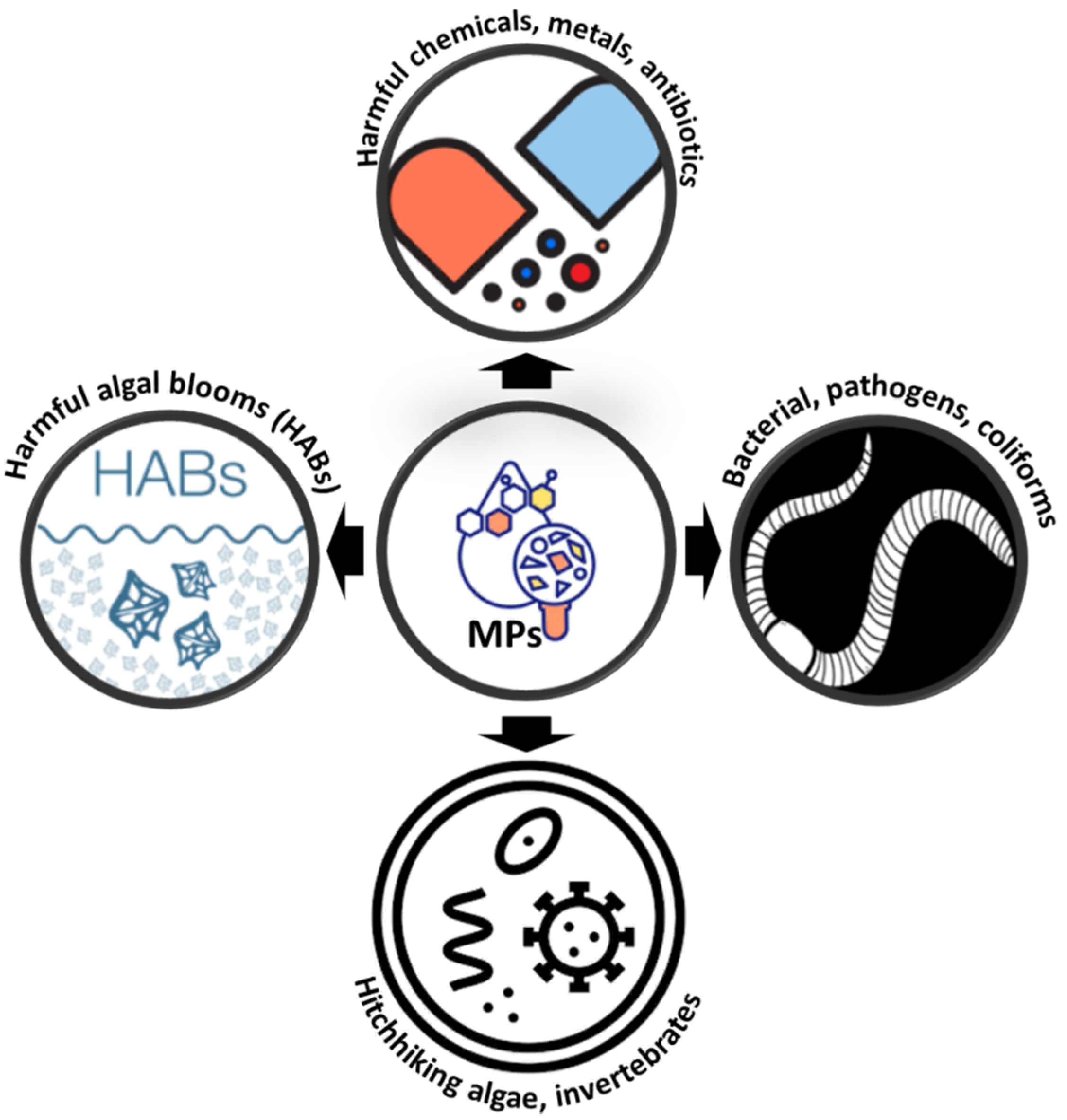
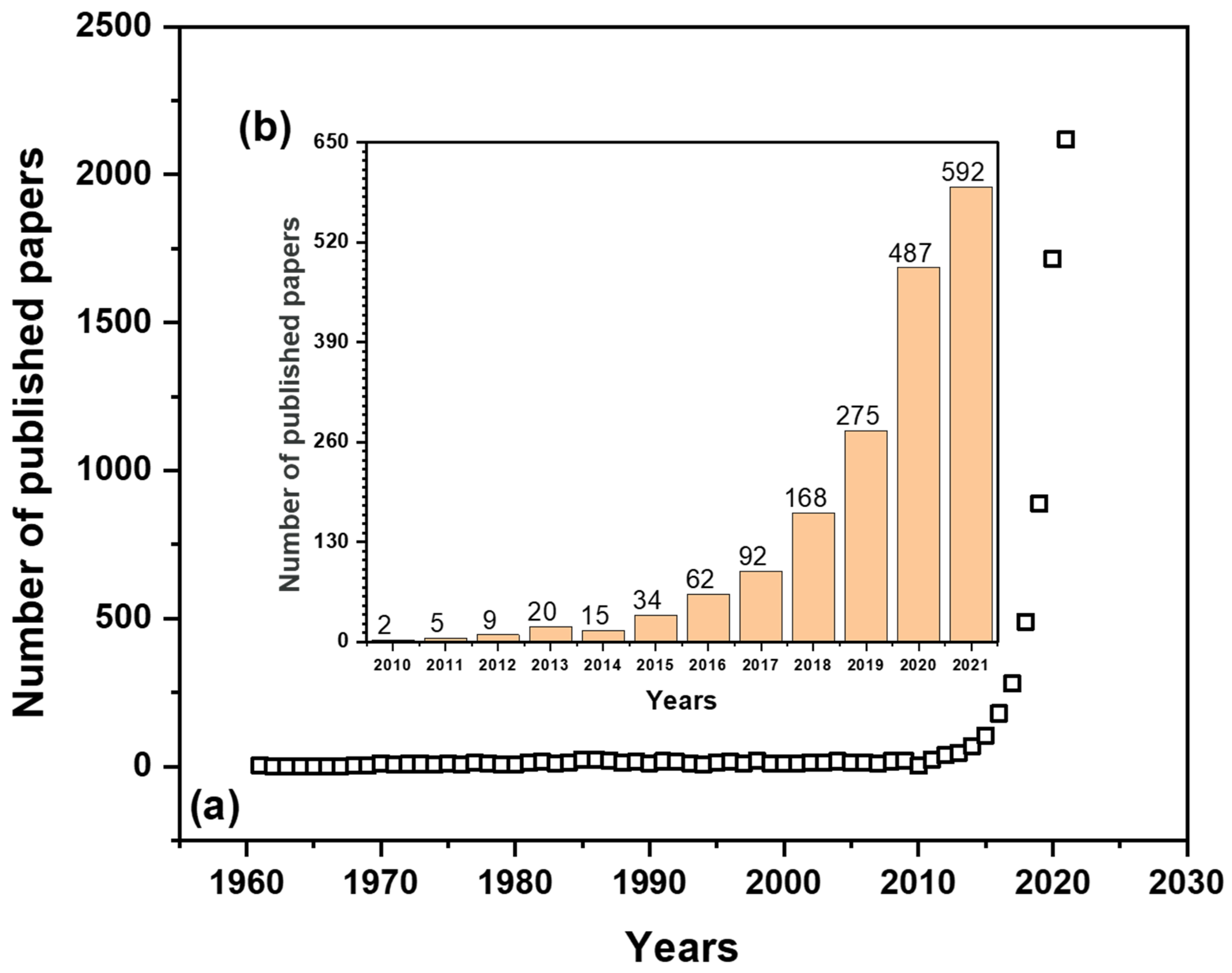
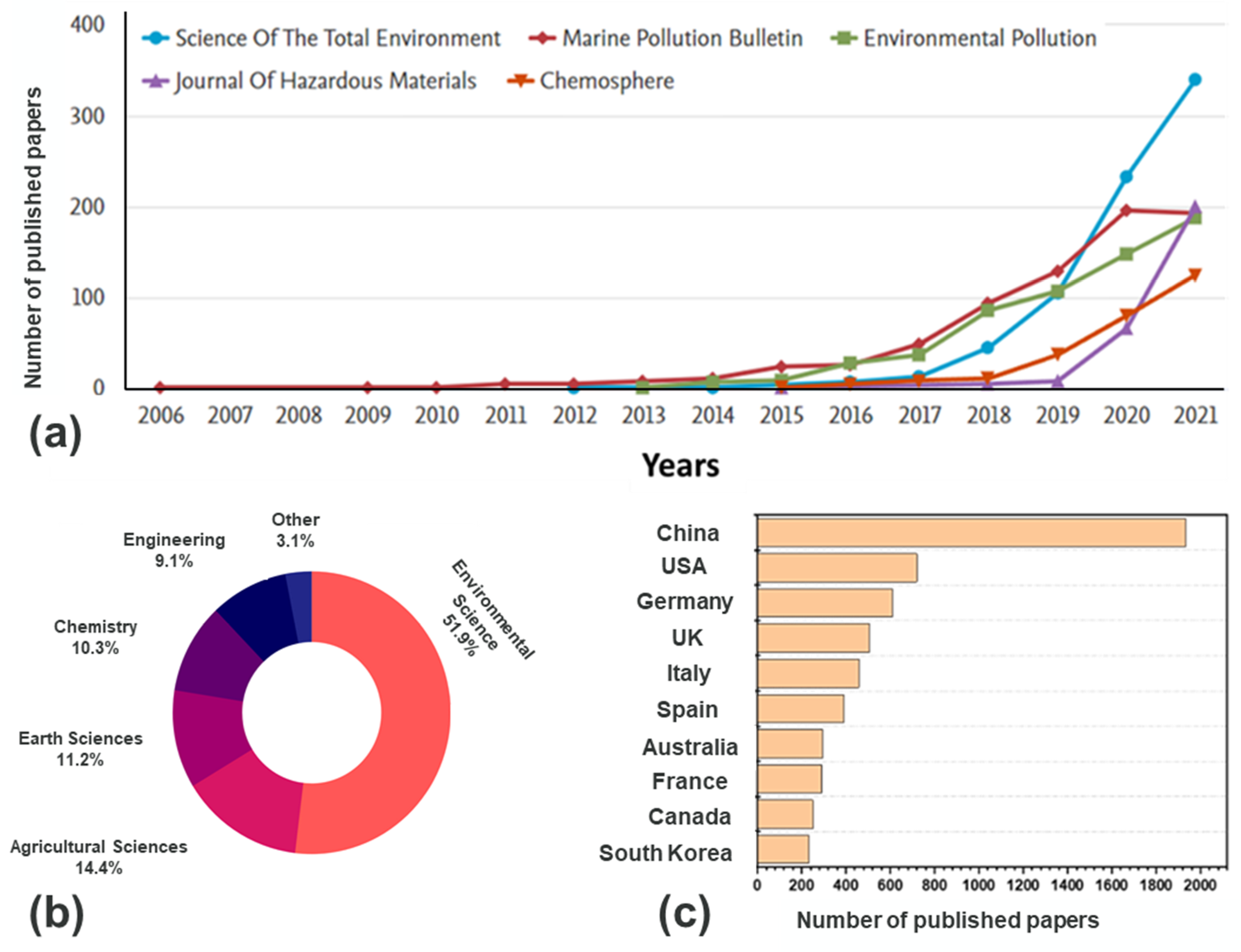
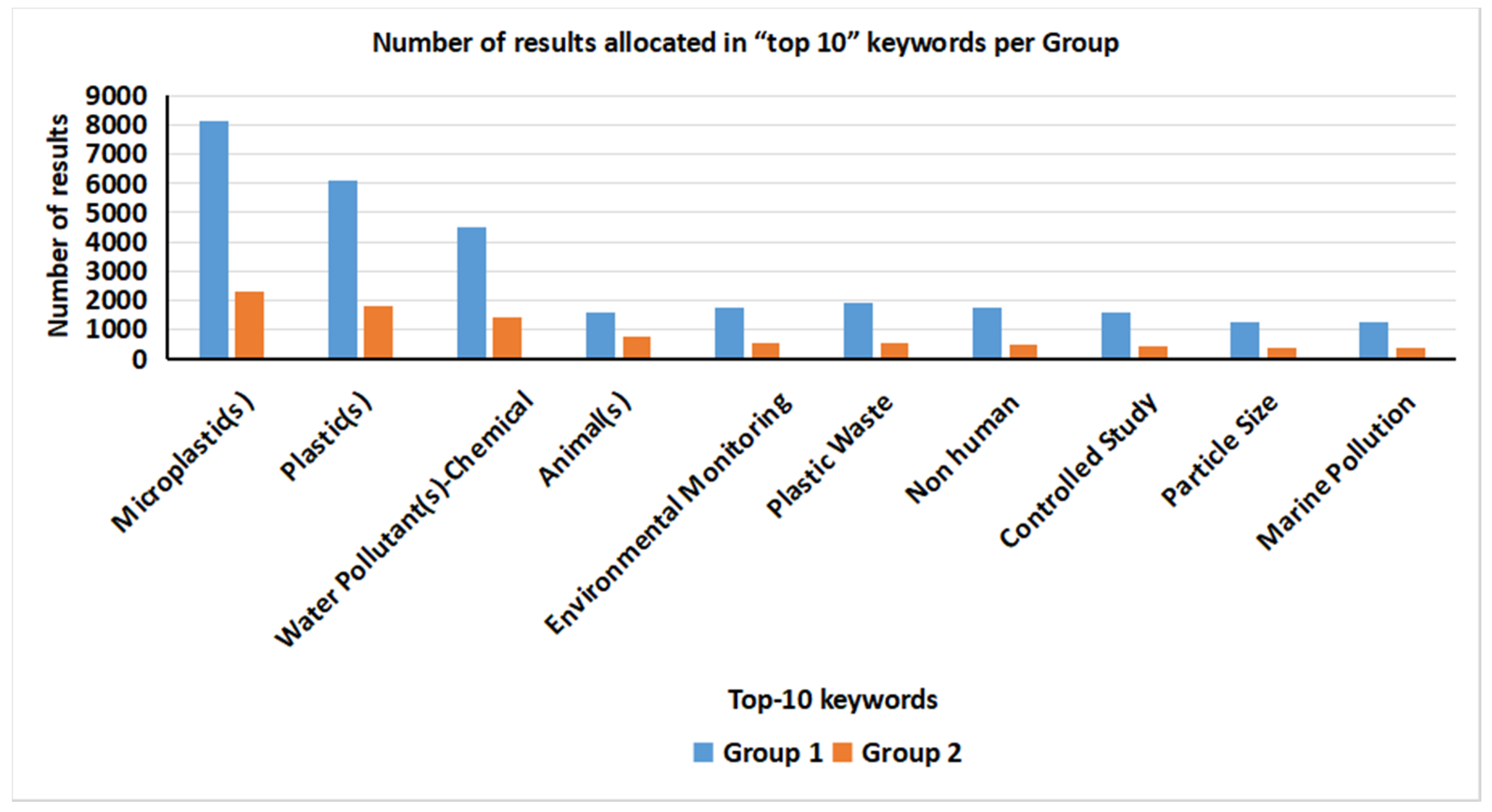

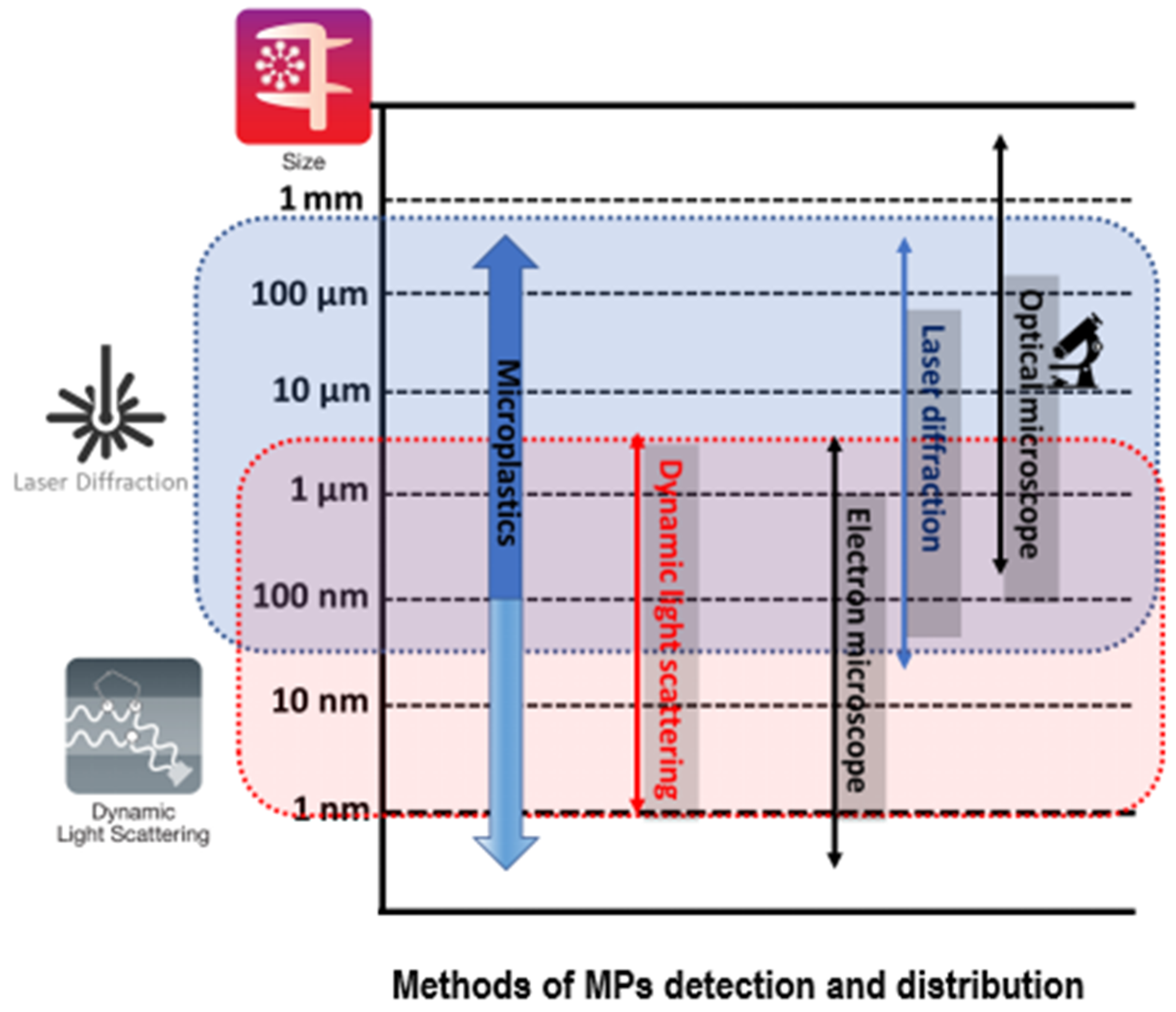
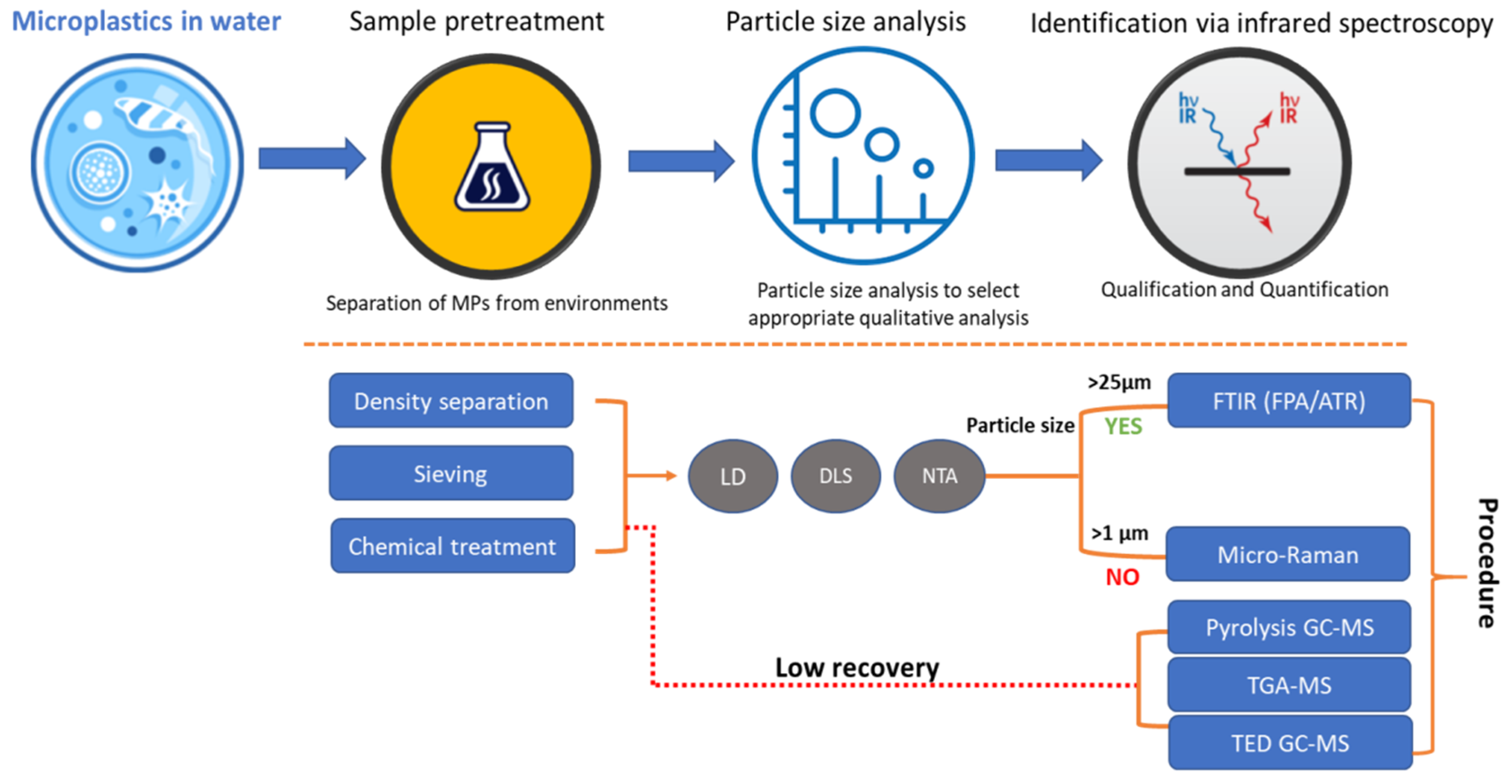
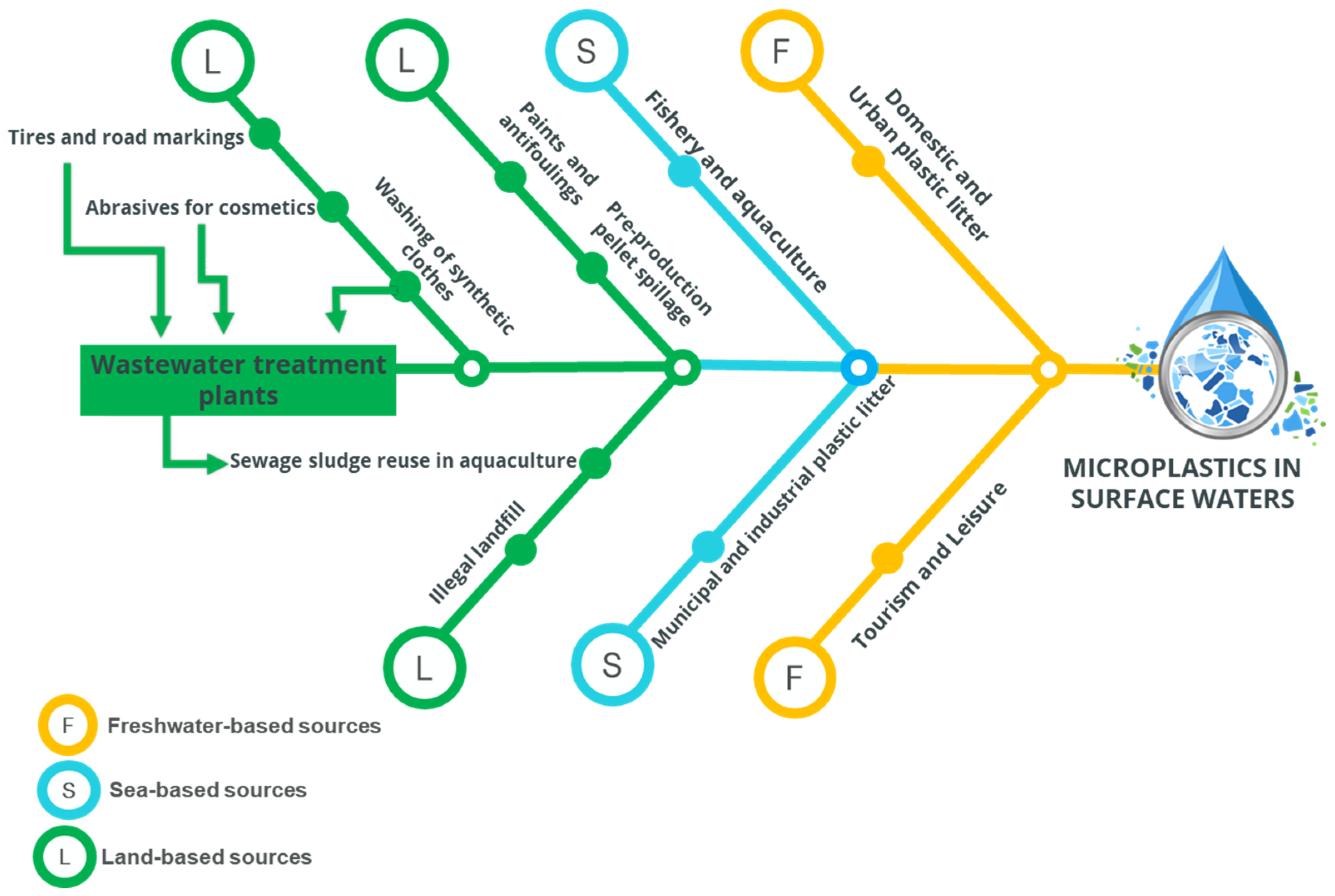
| Top-10 Keywords | Group 1 | Group 1 (%) | Group 2 | Group 2 (%) | ΔGroup (Group 1–Group 2) (Group 2 Basis = “1”) |
|---|---|---|---|---|---|
| Microplastic(s) | 8144 | 10.11 | 2317 | 9.96 | 2.51 |
| Plastic(s) | 6074 | 7.54 | 1830 | 7.87 | 2.32 |
| Water Pollutant(s)—Chemical | 4496 | 5.58 | 1400 | 6.02 | 2.21 |
| Animal(s) | 1604 | 1.99 | 785 | 3.38 | 1.04 |
| Environmental Monitoring | 1741 | 2.16 | 564 | 2.43 | 2.09 |
| Plastic Waste | 1940 | 2.41 | 564 | 2.43 | 2.44 |
| Non-human | 1762 | 2.19 | 475 | 2.04 | 2.71 |
| Controlled Study | 1604 | 1.99 | 433 | 1.86 | 2.70 |
| Particle Size | 1275 | 1.58 | 363 | 1.56 | 2.51 |
| Marine Pollution | 1229 | 1.53 | 349 | 1.50 | 2.52 |
| Subtotal | 29,869 (out of 80,580) | 37% | 9080 (out of 23,255) | 39% | Mean value: 2.31 |
| Regions | Sampling Sites at Freshwater, Coastal, Urban Environments | MPs Concentration—Abundance | Sampling Procedure Characteristics | Ref. |
|---|---|---|---|---|
| North America, USA | North Atlantic Ocean | Fibers (87%), Fragments (13%), 1.62 particles/gram tissue of Hymenaster pellucidus species | ATR-FTIR-microscopy | [5] |
| USA | 0–2.08 × 102 particle day−1 | Total daily discharge from WWTP; sieves of 10–40 μm; FTIR analysis; efficiency: 99% | [12] | |
| USA | 0.20 million metric ton/year | 13% of plastic production annually leads to mismanaged plastic marine debris | [2] | |
| USA, Bay | 4.5 particles/m3 | Mesh opening size >100 μm | [47] | |
| USA, Riverine, Wayni | 0–13.7 particles/m3 | Mesh opening size >100 μm | [47] | |
| South America, Brazil | Brazil | 0.25 million metric ton/year | 16% of plastic production annually leads to mismanaged plastic marine debris | [2] |
| Brazil, Estuary | 0.1 particles/m3 | Mesh opening size >100 μm | [47] | |
| Brazil, Estuary of Goiana | Soft plastic (41.08%), paint chips (29.11%), hard plastic (28.42%), threads (1.4%) 0.26 particles/m3 | Microscopy | [5] | |
| Asia | China | 3.50 million metric ton/year | 11% of plastic production annually leads to mismanaged plastic marine debris | [2] |
| China, Estuary | 67.5 particles/m3 | Mesh opening size >100 μm | [47] | |
| China, Estuary of Changjiang | 20–340 items/kg dry sediment | Fibers; WTP effluent | [29] | |
| China, Reservoir of Three Gorges | 25–300 items/kg dry sediment | Fibers; larger plastic items | [29] | |
| China, River | 0.1–5.6 particles/m3 | Mesh opening size >100 μm | [47] | |
| Hong Kong, Coastal zone | 49–279 items/kg dry sediment | Fragments; WTP effluent, strormwater discharge, illegal dumping, accidents | [29] | |
| Indonesia | 1.25 million metric ton/year | 11% of plastic production annually leads to mismanaged plastic marine debris | [2] | |
| Iran, Coastal zone, Persian gulf | 0–125 items/kg dry sediment | Fibers; WTP effluent, fishing | [29] | |
| Japan, Riverine | 2.0 particles/m3 | Mesh opening size >100 μm | [47] | |
| North Korea | 0.20 million metric ton/year | 9% of plastic production annually leads to mismanaged plastic marine debris | [2] | |
| Pakistan | 0.25 million metric ton/year | 13% of plastic production annually leads to mismanaged plastic marine debris | [2] | |
| Europe | Denmark | (8.16–460) × 106 particle day−1 | Total daily discharge from WWTP; sieves of 10–40 μm; FTIR analysis; efficiency: 95–99.8% | [12] |
| Finland | (1.21–1.68) × 106 particle day−1 | Total daily discharge from WWTP; sieves of 10–40 μm; FTIR analysis; efficiency: 95–97.1% | [12] | |
| Germany | 4.19 × 104–1.24 × 107 particle day−1 | Total daily discharge from WWTP; sieves of 10–40 μm; FTIR analysis | [12] | |
| Hungary, Riverine | 3.52–32.05 particles/m3 | Mesh opening size >100 μm | [47] | |
| Italy, Subalpine Lake Garda | PE (33%), PS (33%), PP (25%), PA (8%) 75 particles/m3 | Raman | [5] | |
| Mediterranean Sea, Central-Western | Fragments (93.2%), Pellets (2.2%), Films (1.6%), Foams (3.1%) 1.25 particles/m3 | ATR-FTIR-microscopy | [5] | |
| Mediterranean Sea, Western | Filaments (86.36%), Fragments (12.12%), Film (1.51%) 0.34 particles/individual Galeus melastomus shark species | FTIR-microscopy | [5] | |
| Scotland, Intertidal zone, Scapa Flow | 730–2300 | Fibers; WTP effluent, marine litter | [29] | |
| UK, Channel | 0–1.5 particles/m3 | Mesh opening size >100 μm | [47] | |
| Beaches | 72–1512 items/kg dry sediment | Fibers; WTP effluent, marine litter | [29] | |
| Africa | Egypt | 0.40 million metric ton/year | 13% of plastic production annually leads to mismanaged plastic marine debris | [2] |
| Nigeria, Riverine | 0–0.2 particles/m3 | Mesh opening size >100 μm | [47] | |
| South Africa | 0.35 million metric ton/year | 12% of plastic production annually leads to mismanaged plastic marine debris | [2] | |
| South Africa, Estuary | 1–7 particles/m3 | Mesh opening size >100 μm | [47] | |
| Oceania | Australia | (8.16–460) × 106 particle day−1 | Total daily discharge from WWTP; sieves of 10–40 μm; FTIR analysis | [12] |
| Australia, Melbourne | 2–147 items/kg dry sediment | Fragments, larger plastic items | [29] | |
| Australia, Sydney Harbour | Fibers (83%), Granules (17%), 0.2–4.6 particles/individual fishes | ATR-FTIR-microscopy | [5] |
| Polymeric Substance | Characteristic Compound 1 | LRI 2 | m/z 3 | LOD (μg) | Density (g/cm3) |
|---|---|---|---|---|---|
| PP | 2,4-dimethyl-I-heptene | 846 | 70 | 0.027 | 0.85–0.92 |
| PE (LD and HD) | I-Decene (C10) | 993 | 83;97 | 0.070 | 0.89–0.97 |
| PA-6 | ε-caprolactam | 980 | 113 | 0.110 | 1.14 (PA–66) |
| PS | Styrene | 898 | 78;104 | 0.003 | 1.04–1.08 |
| PMMA | Methyl methacrylate | 743 | 41;69;100 | 0.029 | 1.18–1.20 |
| uPVC or PVC | Napthalene | 1206 | 128 | 0.592 | 1.16–1.41 |
| PET | Acetophenone | 1076 | 51;77;105 | 0.015 | 1.38–1.70 |
| MP Characteristics | PP | PE | PS, PAM, PVC |
|---|---|---|---|
| Atlantic Ocean water, 1.15 particles/m3 | Polyester: 49% | PA/acrylic polyester: 43% | Analysis: FTIR |
| Atlantic Ocean water, size distribution | 0.25–0.5 mm: highest number | 0.25–0.5 mm: highest number | - |
| Density (g/cm3) | 0.85–0.92 | 0.89 (LDPE); 0.94 (HDPE) | 1.04–1.08 (PS) 1.16–1.41 (PVC) |
| European coastal waters, 13–501 particles/m3 | 48% | 48% | 4% PS; 11% PA Analysis for concentration and particle size distribution: slight microscopy |
| Size distribution | 5–10 μm: 30–40% | >10 μm:<10% | >100 μm: <2% |
| Size distribution | 1–5 μm: 25–60% | 5–10 μm: 30–50%; 10–50 μm: 10–60%; 50–100 μm: 0% | |
| Size distribution (μm) | - | - | 62.38 (PS); 53.58 (PA); 59.97 (PVC) |
| Surface area (m2/g) | - | - | 4.13 (PS); 9.51 (PA); 5.29 (PVC) |
| Surface seawater, 545 particles/m3 | 11.1% | 77.8% | PE/EA: 11.1% Analysis: FTIR spectroscopy |
| Surface seawater, Size distribution | <0.5 mm: highest number | <0.5 mm:highest number | 0.5–5 mm |
| Total pore volume (cm3/g) | - | - | 0.044 (PS); 0.090 (PA); 0.051 (PVC) |
| WTP drinking water | 16–33% | 0–35% | PAM, PVC < 10% |
| WTP raw water | 16–26% | 0–24% | PS, PAM, PVC < 10% Analysis: 10 µm: FTIR; <10 µm: Raman; SEM |
Publisher’s Note: MDPI stays neutral with regard to jurisdictional claims in published maps and institutional affiliations. |
© 2022 by the authors. Licensee MDPI, Basel, Switzerland. This article is an open access article distributed under the terms and conditions of the Creative Commons Attribution (CC BY) license (https://creativecommons.org/licenses/by/4.0/).
Share and Cite
Kyriakopoulos, G.L.; Zamparas, M.G.; Kapsalis, V.C. Investigating the Human Impacts and the Environmental Consequences of Microplastics Disposal into Water Resources. Sustainability 2022, 14, 828. https://doi.org/10.3390/su14020828
Kyriakopoulos GL, Zamparas MG, Kapsalis VC. Investigating the Human Impacts and the Environmental Consequences of Microplastics Disposal into Water Resources. Sustainability. 2022; 14(2):828. https://doi.org/10.3390/su14020828
Chicago/Turabian StyleKyriakopoulos, Grigorios L., Miltiadis G. Zamparas, and Vasileios C. Kapsalis. 2022. "Investigating the Human Impacts and the Environmental Consequences of Microplastics Disposal into Water Resources" Sustainability 14, no. 2: 828. https://doi.org/10.3390/su14020828
APA StyleKyriakopoulos, G. L., Zamparas, M. G., & Kapsalis, V. C. (2022). Investigating the Human Impacts and the Environmental Consequences of Microplastics Disposal into Water Resources. Sustainability, 14(2), 828. https://doi.org/10.3390/su14020828








